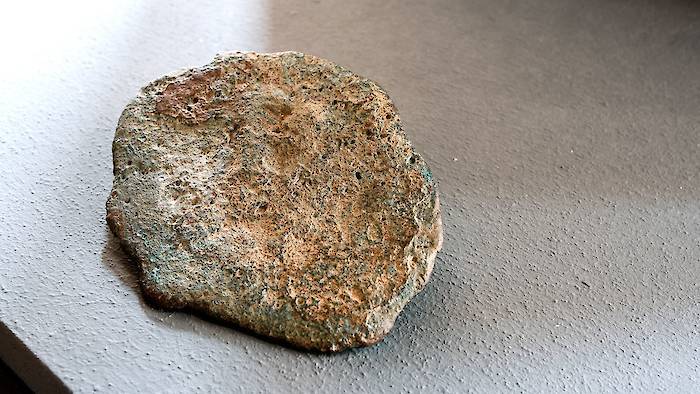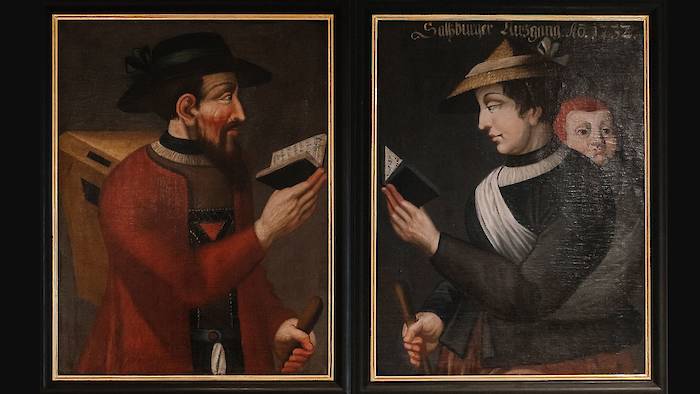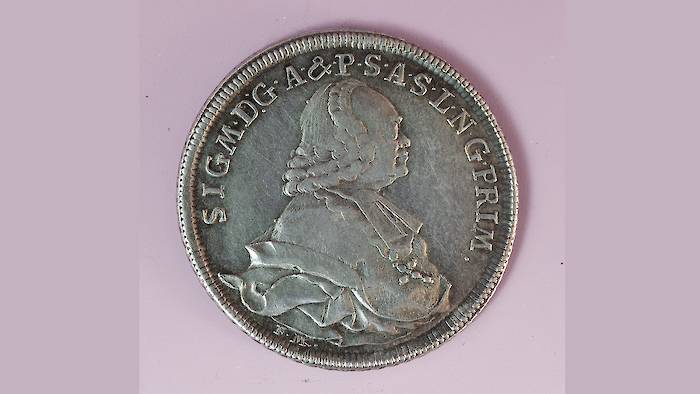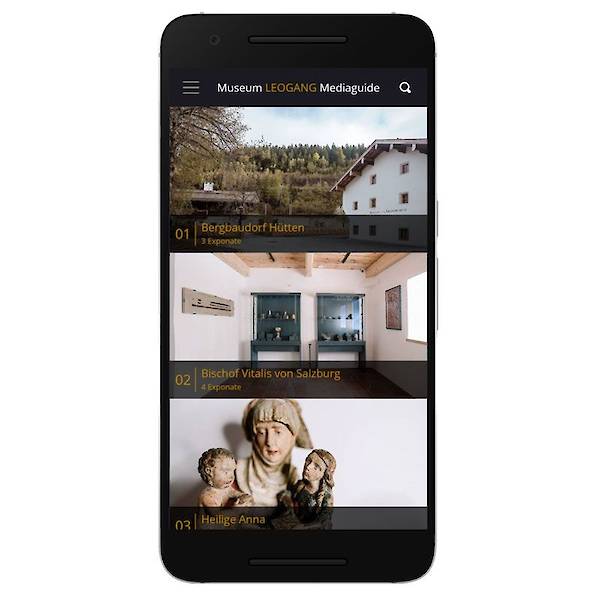A selection of our current exhibits
- Cast copper cakeHistorical find
 Cast copper cakeHistorical find
Cast copper cakeHistorical findIt is thanks to a fortunate coincidence that the Mining and Gothic Museum is in possession of a cast bronze cake. This is the name for a by-product of primeval copper processing. The valuable raw material was primarily intended for further processing at the coppersmiths but was also used as payment during the Bronze Age.
In 2018 a German family salvaged this example after a mountain tour in late summer from a waterhole of the Schwarzleo stream in the vicinity of the Bronze Age mine discovered in 2004.
Mining activity during the Bronze Age took the form of an open-cast mine; this was proven by excavations by Robert Krauss and Martin Seiwald.
The family found fragments of large storage vessels made of clay mixed with slag, fine ceramics in the form of a small bowl and almost completely preserved spruce wood shingles, which probably once formed the roof of a living or workspace. Secondary minerals in the form of malachite and azurite can be found throughout the entire early mining site.
The discovery of the cast copper cake means that the smelting of ores in the mining district of Schwarzleo, while not yet proven, can now at least be assumed.
The cast copper cake, found in the summer of 2018 in the Schwarzleo stream, weighs 651 g, is oval-shaped and, with a thickness of 1 cm, relatively flat compared to other finds.
The material is solid and free of slag and charcoal. However, whether it is pure copper or copper alloy in the form of bronze will only be revealed through ongoing investigations.
Pure copper would secure Leogang as the place of origin, whereas bronze would have been delivered as for the production of mining tools.
The cast copper cake has signs that it has been at the bottom of the stream for a long time. Sanding sediments have round the edges and in some areas removed the rich green malachite patina down to the metal.
Thanks to the finders’ great understanding the cast copper cake was donated to the Mining and Gothic Museum and represents an important find for research into Leogang mining.
- Portraits of Salzburg exilesTwo portraits in typical folk costume
 Portraits of Salzburg exilesTwo portraits in typical folk costume
Portraits of Salzburg exilesTwo portraits in typical folk costumeThe march of the 1731 and 1732 émigrés from Salzburg to East Prussia caused a great stir among the German principalities and also found its expression in the visual arts.
The two portraits show a man and woman in typical Salzburg dress. The man has a prayer book in his right hand in which you can even recognise the Bible passages. In his left is a walking stick and on his back, a large, wooden box in which the émigrés carried their essentials, needed on their long march. Even the details are precise; the man’s initials appear on his braces.
The woman is carrying her child on her back in a linen cloth. She too has a prayer book, in her left hand, and a walking stick in her right. Above her is the inscription ‘Salzburg Exile Anno Domini 1732’.
The origin of the portraits is unknown.
- Coins from Leogang silverSought-after collectors’ items
 Coins from Leogang silverSought-after collectors’ items
Coins from Leogang silverSought-after collectors’ itemsThe quality of the silver from the mines in medieval Leogang was excellent and it was used for minting gold and silver coins by the Salzburg archbishops, whose archbishopric was both imperial estate and mint estate of Bavaria.
Salzburg coins from around 1500 are closely connected with one name in particular, Archbishop Leonhard von Keutschach. When he came to power shortly before 1500, the domestic coinage and monetary system was in a state of disrepair.
Salzburg was in possession of huge amounts of gold and silver deposits, among the largest in Europe. But since nearly all the noble metal had been sold to Venice by a trading company there was a state-wide lack of coinage. Not a single coin had been minted for over 30 years.
Foreign money was coming into Salzburg but this was not enough to fulfil the demands of the economy. Leonhard von Keutschach had to act. Against the will of the powerful trading companies, he put a stop to the export of gold and silver and from then on had Salzburg’s noble metal made into its own coinage.
In earlier centuries it was almost exclusively small silver coins, called pfennigs, that were minted. If somebody wanted to pay a large sum they would have to use hundreds or even thousands, which was very impractical. The well-off were known to use silver bars or foreign gold coins for such payments.
Leonhard von Keutschach put a stop to all this. He introduced a modern system with different sizes and values of coin in gold and silver. Pfennigs remained, as the currency of the average Joe.
Batzen were favoured for medium-sized payments. They were worth 16 pfennigs. For larger payments it was possible to use gold gulden. They were worth the same as 240 pfennigs, a week’s salary for a paid mine worker. Only a few people would ever hold one of these in their hand.
Leonhard von Keutschach’s most famous coin was the turnip thaler, the first Salzburg silver coin to be worth the same as a gulden. The archbishop used the turnip thalers as presents rather than payments. Why were they called turnip thalers? Because of the turnip in the archbishop’s coat of arms. The same turnip could be found on all of Leonhard von Keutschach’s coins.
From the Middle Ages on, high quality medals and coins, desired throughout the empire, were created at the Salzburg mint. Renowned medallists such as Peter and Paul Seel, Philipp Heinrich Müller, Philipp Christoph Becker, Georg Raphael Donner and various generations of the Matzenkopf family created medals and coins which acquired an excellent reputation beyond the borders of Salzburg and still go for top prices at auction today.
Our Museum Audio Guide
Interested in our exhibits?
Our free media guide provides fascinating information.
Have a look: Audio-Guide
